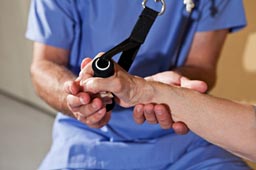Joint Hypermobility

What is Joint Hypermobility Syndrome?
Joint Hypermobility is a condition in which the body’s joints are easily stretched beyond normal positioning, especially in the fingers, wrists, elbows, and shoulders.
According to some studies, around 10-15% of children have hypermobile joints. This makes children some of the most common patients for injuries that stem from having hypermobile joints that do not provide enough stability.
In general, individuals with hypermobile joints may begin to display symptoms during childhood. As we age, flexibility tends to decrease – even in individuals with joint hypermobility syndrome.
Signs and Symptoms of Joint Hypermobility
One of the most blatant signs or joint hypermobility syndrome is a patient being able to bend, or rotate, their joints further than the norm. For example, someone with hypermobile joints may be able to bend their thumb to touch their forearm, extending it much farther than the average person.
Other symptoms of joint hypermobility syndrome include pain in the affected joints. In some cases, scoliosis can also accompany joint hypermobility syndrome as there is some association between the two conditions.
Causes of Joint Hypermobility Syndrome
Joint hypermobility syndrome can be an inherited trait, with children born to parents with hypermobile joints being more likely to have “loose” joints. Joint hypermobility is also linked to an individual’s collagen production, which is key in helping joints stay stable with limited, normal ranges of motion.
However, some conditions are known to cause joint hypermobility, such as:
- Marfan syndrome
- Ehlers-Danlos syndrome
- Bone development disorders
- Connective tissue disorders
- Morquio syndrome
- Down syndrome
Injuries Associated with Joint Hypermobility
Since loosely stabilized joints are easily injured, subluxated or dislocated, the most effective treatment is to strengthen the muscles and improve reflexes around the lax joints so that they may be adequately held in place.
As many children have joint hypermobility syndrome, sprains, strains, and fractures can be common injuries caused by joint hypermobility. Without strong, proper structures keeping the joint in place, it’s easy for joints to become misaligned and injured in an individual with joint hypermobility syndrome.
Over time, joint hypermobility accompanied by instability is associated with joint pain, stiffness, arthritis, or degenerative conditions that impact the joints.
Getting a Diagnosis for Joint Hypermobility
If you believe you or your child have joint hypermobility syndrome, it’s important that you are seen by a skilled orthopedic hand surgeon. Dr. Mark Pruzansky and Dr. Jason Pruzansky have vast experience treating patients with many hand conditions and injuries, including hypermobile joints.
To diagnose joint hypermobility syndrome, your skilled orthopedic hand specialist may evaluate whether or not you can place your palms on flat on the ground while keeping your legs straight, if your elbows and knees can bend backward, if your thumb can touch your forearm, or if your finger can bend beyond 90 degrees backward.
If You Believe You Have Joint Hypermobility Syndrome, Contact HandSport Surgery Institute
Please contact us as soon as possible to schedule an appointment with our talented team. Hypermobile joints should be evaluated to try and reduce the risk of injury and degeneration from occurring.
If you have been injured, it’s important to be evaluated by a highly skilled professional. Call Dr. Mark Pruzansky and Dr. Jason Pruzansky at 212-249-8700 to schedule an appointment and obtain an accurate diagnosis.



